Have you heard that diabetics must see a podiatrist every year? Do you know why? An unfortunately large percentage of the population suffers from the medical condition diabetes. Diabetes can affect many parts of the body, but often one of the first signs of worsening diabetic control will happen in the nerves and arteries of the feet. Diabetic feet can also get ulcers which don’t heal and can lead to hospitalisation, amputation and even death. This is why caring for and checking diabetic feet is so important.
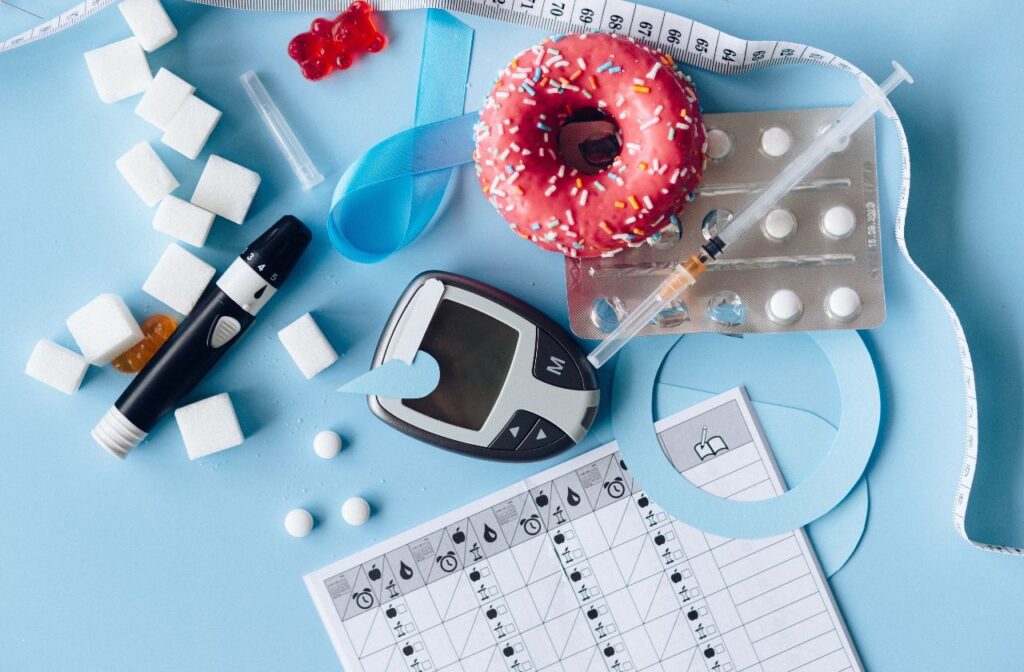
What is diabetes?
Diabetes is a chronic condition that affects the way the body processes blood sugar, also known as glucose. Glucose is the main source of energy for the body’s cells, but it relies on insulin to be transported into cells. In diabetes, the body either does not produce enough insulin or cannot use it properly. This causes glucose to build up in the blood instead of being absorbed normally. High blood glucose levels can lead to a range of health problems over time, including damage to the eyes, kidneys, nerves, and heart.
There are two main types of diabetes:
- Type 1 – usually diagnosed in childhood and is caused by the immune system attacking the insulin-producing cells in the pancreas
- Type 2 – More common and usually develops later in life due to a combination of genetic and lifestyle factors
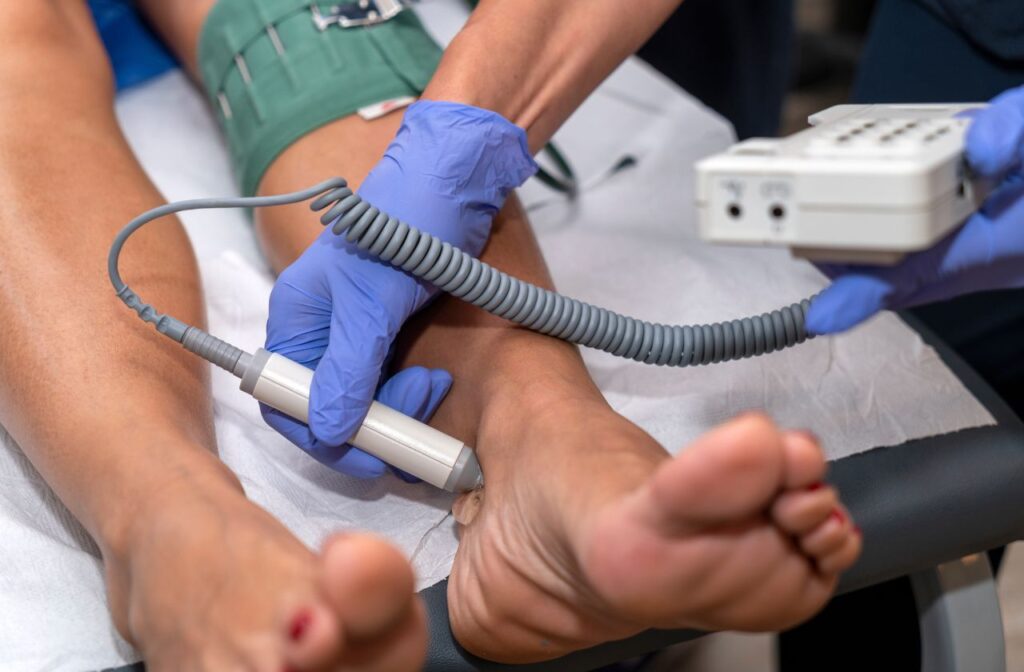
How does diabetes affect feet?
Broadly speaking, diabetes can affect a person’s feet in 4 main ways:
1. Blood supply
Excessive blood glucose levels affect the smaller blood vessels in the body (found in our feet, hands, eyes etc.). Over time these blood vessels become damaged and can no longer pump as much oxygenated blood as before. This can lead to poor wound healing, higher risk of developing long lasting infections and tissue death which can lead to amputation.
2. Nerve Function
Nerves are important for both muscle tone and balance along with detecting various sensations. In diabetes, nerves can progressively decline to the point of permanent loss of sensation in the feet; this is called Peripheral Neuropathy. Peripheral neuropathy causes interrupted pain signals; these are the body’s way of alerting us when there is something wrong. This means there is a much higher risk of injury and deformity occurring.
3. Diabetic foot ulcers
Every year over 27,000 people are hospitalised for diabetic foot ulcers. These foot ulcers occur from everyday simple wounds such as minor cuts, ingrown toenails or embedded foreign objects. Due to changes in blood supply, nerve function and tissue health, these injuries are detected late, easily infected and slow or unable to heal. These non healing wounds then land people in hospital with severe and worsening infections. Often to save life, amputations have to happen, which is a sad reality for more than 4000 Australians every year.
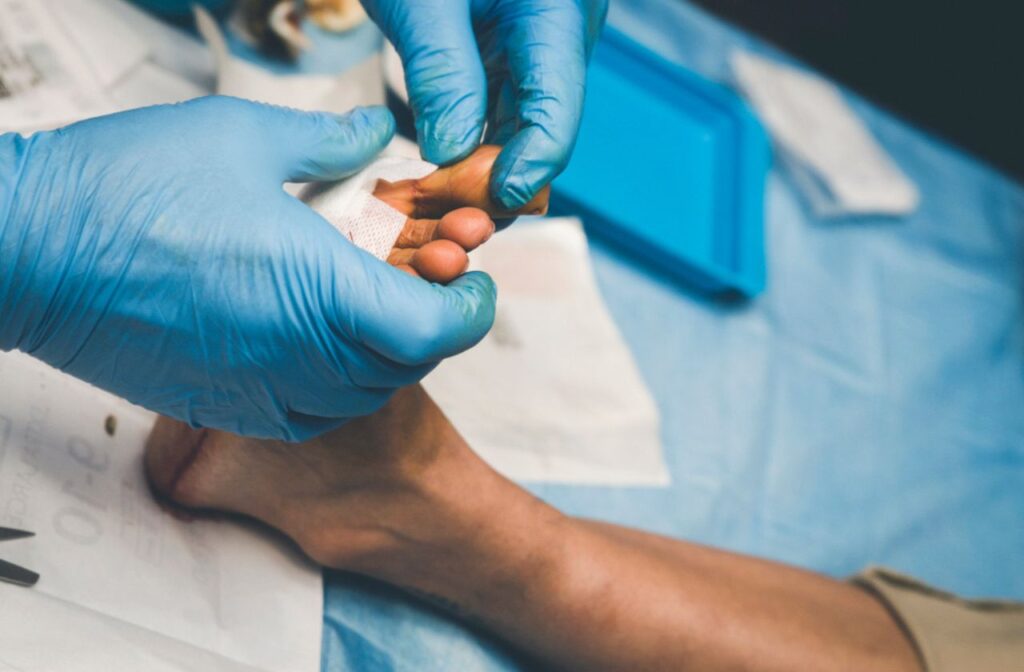
4. Foot deformity / Charcot neuroarthropathy
If diabetes causes neuropathy in the feet, another devastating complication which can occur is charcot neuropathy, commonly shortened to ‘charcot foot’. Charcot is essentially a severe, sudden and very destructive arthritis which occurs in weight-bearing joints in the feet (commonly the midfoot – where the arch of your foot is) of people with peripheral neuropathy. Charcot foot can appear similar to an infection, with symptoms of redness, heat and swelling – however there will be no injury or obvious cause. If left untreated it can lead to major and life-long foot deformity. Charcot is considered a medical emergency as it progresses so rapidly.
What does a podiatrist do for diabetic feet?
Diabetes can cause a range of foot problems, and podiatrists are experts in managing and treating these issues. Podiatrists play a vital role in preventing serious foot complications in people with diabetes, such as foot ulcers, infections, and even amputations. They work with patients to conduct regular foot exams to check for any signs of peripheral arterial disease, peripheral neuropathy, and damage or injury, such as cuts, blisters, or calluses. We podiatrists can also treat diabetic foot ulcers in the community; often healing most ulcers and referring on more serious cases to the hospital system. All of this is done with the aim of catching problems early, reducing hospitalisation and preventing as much disease impact as possible for the population of people living with diabetes.
In addition, podiatrists can prescribe custom orthotics and footwear to help relieve pressure on the feet and prevent or heal ulcers. Podiatrists are an essential part of the healthcare team for people with diabetes, helping them to maintain healthy feet and avoid serious complications.
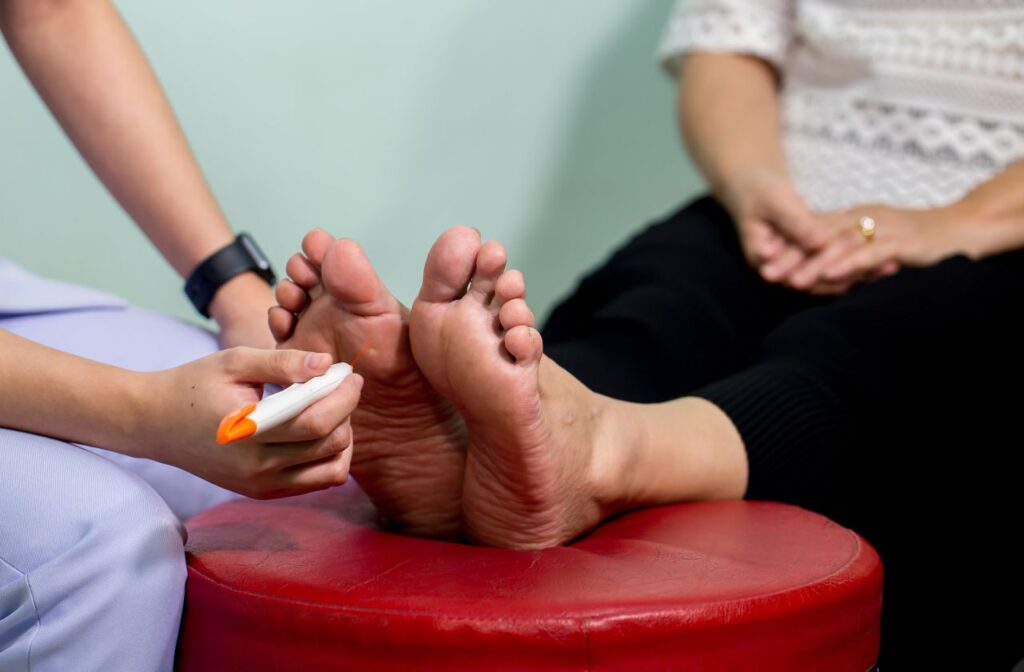
What is a diabetic foot check?
A podiatrist should always be part of your diabetes health-care team. Your GP will often refer you to a podiatrist for a diabetic foot assessment. Seeing a podiatrist regularly is recommended even without a referral. Foot assessments are especially important if you have been recently diagnosed with diabetes or have a history of previous complications.
Your Podiatrist will carry out various tests in 4 main areas to determine and monitor your foot health. These give us a good indication as to where you stand on the risk scale for diabetes related complications, such as developing non-healing wounds (ulcers) and risk of amputation.
1. Circulation
There are two main arteries that lead into the foot. We listen to these and check the quality of blood flow by using a diagnostic ultrasound machine called a Doppler.
2. Nerves
Different nerves are responsible for different things in our feet: light touch, temperature, pressure, vibration, reflexes…etc. It is important to see if there have been any changes in function as they form your main protective system from injury.
3. Muscle Power
Muscle strength can have an impact on your balance, and whether or not injury will occur when moving around and exercising.
4. Range of motion and structure of the foot
Restrictions in joint movement can lead to injury and or pain while loose ligaments and joints can also lead to being unstable and can result in injury.
How are the results of a diabetic foot check used?
Results of the foot assessment will give you a risk level of future complications (particularly foot ulceration), ranging from ‘Low’ to ‘Acute’. We use this to determine whether further intervention is needed, such as a detailed vascular or neurological assessment. We include these results in a report to your GP; it’s important for both you and your GP to know.
The regularity of these assessments depend on the results from the initial assessment. If everything is normal, we typically do the diabetes foot health check annually. If you are at a higher risk of complications, your podiatrist will advise you to return more frequently and work with you on a long-term management plan.
Even if you are at low risk, you will be given tailored information to help you protect and manage your feet at home safely. The podiatrist will also look at more general ways to improve your quality of life. For example, they may recommend treatments such as orthotics, a change in footwear or an exercise programme. If it would benefit you, they can initiate referrals to other allied health professionals such as exercise physiologists.
What can I do to care for my diabetic feet?
Seeing a podiatrist is important, but there are also lots of things you can do at home to care for your diabetic feet:
Foot hygiene and moisturising for diabetic feet
The number one tip to avoid problems like fungal infections, ulcers and bacterial infections occurring is to keep the skin of your feet in good condition with proper foot hygiene. Proper foot hygiene means keeping the skin of the feet clean with regular bathing, ensuring they are well dried afterwards (especially between the toes) and applying a moisturising cream daily.

If bending down to your feet is hard for you to do, here are some tips:
- Purchase or make a small sponge/washcloth on a stick to help you clean your feet.
- Put a seat in the shower so you can reach your feet to clean them.
- If you can’t bend at the hip – there are some mats you can purchase to place on the shower floor and rub your feet over to clean.
- Sit down to dry your feet or place a towel on the floor to help you.
- Pharmacy’s sell long-handle cotton tips which can help you dry in between your toes.
- If you have trouble applying moisturiser – squirt some onto the top of your feet and rub your feet together. This may not be perfect, but it is much better than nothing!
- If you feel comfortable, ask a family member, friend or partner to help you.
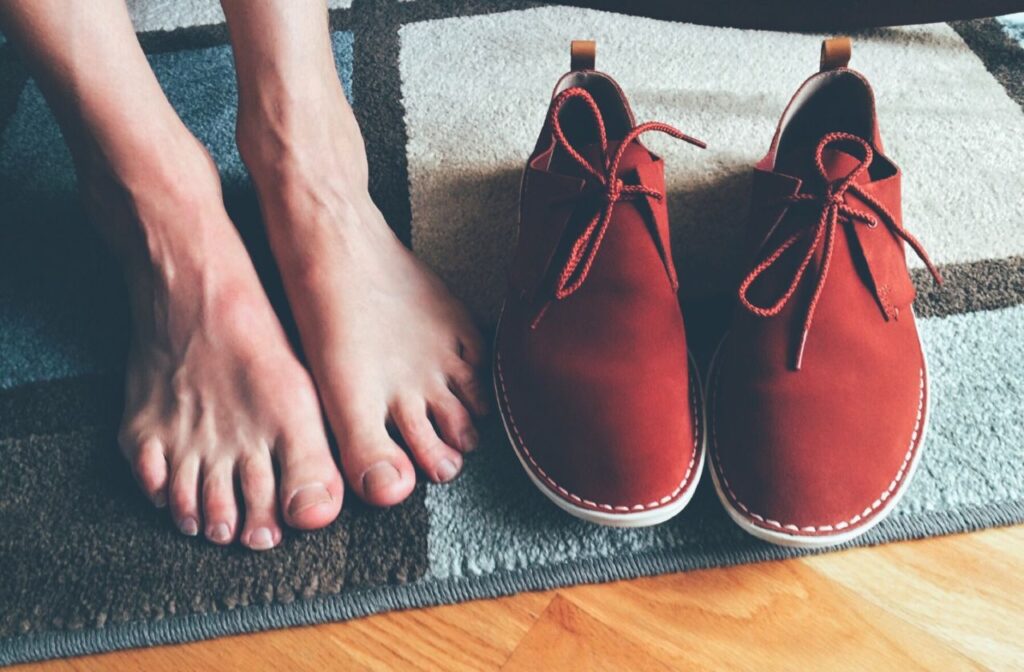
Footwear choices at home for diabetic feet
Even when you are at home, it is still extremely important to have something on your feet. Wearing shoes or slippers around the house will protect your feet from foreign bodies. It will also reduce the pressure on the skin. This reduces the amount of callus (hard skin), corns and ulcers developing. If you are at high risk of diabetic foot ulcers or have one on your foot, the footwear you wear becomes an essential part of your treatment – the right shoe can heal ulcers! It is very important that you listen to the advice of your podiatrist regarding footwear and follow their recommendations even at home!
Keeping diabetic feet warm in winter
When the weather cools down often the most cold part of the body will be the feet. Blood has further to travel to reach your feet, and this only gets worse if we have a condition like diabetes. So what is the best way to warm icy cold feet? Well, while tempting, avoid very hot items like hot water bottles and electric blankets. These items, particularly if used overnight, have a high probability of creating a burn. If you have peripheral neuropathy, they are an absolute no-no!
Safer ways to keep diabetic feet warm include:
- Wear thick insulated socks – wool and natural fibres are great for maintaining heat while staying breathable.
- Wear two pairs of socks.
- Keep active – avoid sitting for long periods with your legs elevated. Keep moving to encourage blood flow to your feet. Go for a short walk. If you want to stay sitting, draw the alphabet with both feet in the air.
- Consider trying a paraffin wax bath which will provide long-lasting deep heat to the feet.
Conduct daily foot checks
These are so essential! To complete a daily foot check:
- Sit down and examine the top of both feet – check for any discoloration to the skin or nails, cuts, redness, blisters or rashes.
- Check the bottom of your feet by either:
- Bending one leg to look at the underside of the first foot and perform the same visual check.
- If you are unable to bend your leg to check, either get someone else to check for you, or use a small mirror against the wall to look while you bend up your foot at the ankle.
- Spread your toes and check in between for skin breaks or soggy, flakey or red skin.
- Repeat the above two steps for the other foot.
- Before you put your shoes or slippers back on, check the inside for any sharp edges or debris which may injure your feet.
- See a podiatrist if you identify anything abnormal.

What products are available for diabetic feet?
Moisturisers and emollients
Maintaining adequate skin moisture and elasticity is extremely important to reduce the risks of broken skin which may lead to cuts, fungal or bacterial infections. Some of these may contain synthetic urea to soften hard skin (callus).
Diabetic socks
These will reduce the risk of irritation to the skin or interruption of blood flow from the socks. They are designed with limited seams, soft breathable materials and looser elastic.
Diabetic shoes
Specialty shoes are designed to provide appropriate support, cushioning and breathability for diabetic feet to reduce the risk of foot ulceration from pressure spots. The insides of the shoes are also smooth and roomy with no spots which will rub or put pressure on the feet.
Shoe inserts/custom orthotics
These are the next step in reducing pressure hotspots in the feet. They are more effective than footwear alone and often medically necessary if there has been ulceration to your feet in the past.

How do I see a podiatrist for diabetic feet?
Hopefully by now you have learned the value in seeing a podiatrist for you diabetic feet. We would love to be part of your regular diabetes health care team!
To see on of our friendly podiatrists call 1300 76 33 66 or book online!


